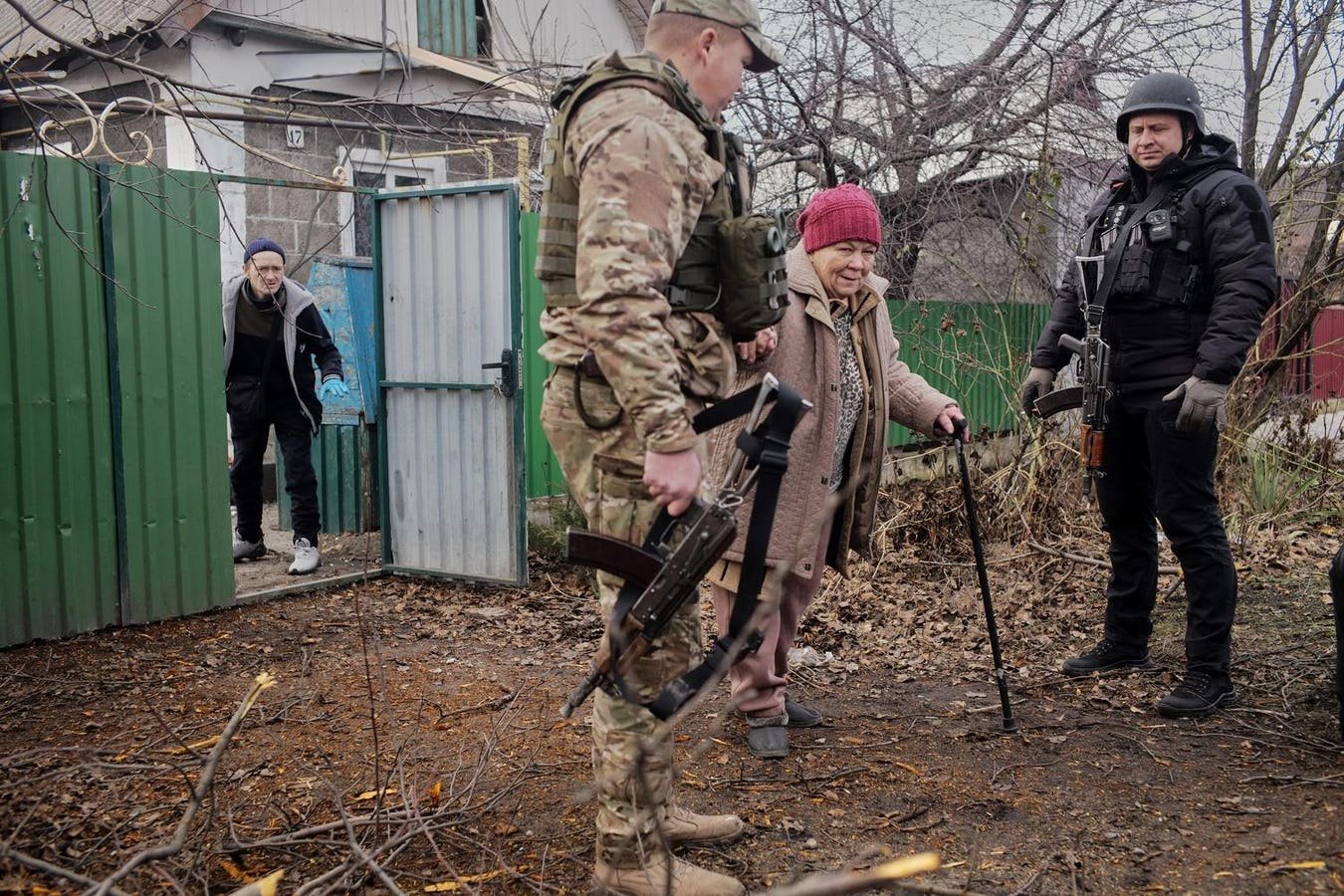DONETSK OBLAST, UKRAINE – JANUARY 26: Civilians are being evacuated from the frontline city of … [+] Pokrovsk by officials in Donetsk Oblast, Ukraine on January 26, 2025. (Photo by Piotr Sobik/Anadolu via Getty Images)
Dispatches from Ukraine 1,069.
Donetsk region. Russia’s systematic artillery and glide bomb attacks on Ukraine’s eastern region of Donetsk killed two civilians and injured six others over the past three days.
Kharkiv region. In Ukraine’s northeastern Kharkiv province, a Russian glide bomb struck a residential area two miles from the frontlines, near the city of Kupyansk, killing two women on Jan. 26.
Dnipropetrovsk region. A Russian drone attack on the central-eastern oblast, or region, damaged apartment buildings and ignited a fire in the city of Dnipro late on Jan. 27. No casualties have been reported.
A joint investigation by the independent Russian news outlet Mediazona and BBC News Russian has identified more than 90,000 Russian military deaths since its invasion of Ukraine. Meticulously researched by compiling data from obituaries, military memorials and cemetery records, the report reveals a toll far exceeding the Kremlin’s official figures. Notably, nearly 10,000 new casualties were verified in the past three months alone.
Military experts estimate that this public record analysis can likely only account for 45–65% of Moscow’s losses, suggesting the actual number of Russian fatalities could range between 138,500 and 200,000 when fallen troops, whose remains have yet to be recovered, are factored in. Including casualties among separatist forces in Ukraine’s eastern Donetsk and Luhansk regions, total Russian-aligned losses could reach between 159,500 and 223,500 soldiers.
Ukraine has also endured a substantial toll, with at least 68,000 verified military deaths to date. Civilian casualties in Ukraine have surpassed 12,160 dead and 26,900 injured, with Ukrainian officials estimating more than 20,000 deaths in the obliterated southeastern city of Mariupol, alone.
On Jan. 27, the European Union extended its sanctions on Russia in response to the ongoing war in Ukraine for another six months. The renewal was nearly blocked by Hungary, which had previously threatened a veto. However, Budapest agreed to back the extension after the EU issued a statement promising to continue discussions on energy supply through Ukraine, addressing Hungary’s concerns about the suspension of Russian gas transit.
Since Russia’s invasion in 2022, the EU has imposed 15 rounds of sanctions, with Hungary frequently calling for their suspension. The latest extension follows weeks of diplomatic tension, driven in part by Hungary’s objections to Ukraine’s halting the delivery of Russian gas to Europe via its territory as of Jan. 1.
UKRAINE – JANUARY 11: (——EDITORIAL USE ONLY – MANDATORY CREDIT – ‘UKRAINIAN PRESIDENT VOLODYMYR … [+] ZELENSKY’S SOCIAL MEDIA / HANDOUT’ – NO MARKETING NO ADVERTISING CAMPAIGNS – DISTRIBUTED AS A SERVICE TO CLIENTS——) A photo shows an alleged North Korean soldier held after being captured by Ukrainian army on January 11, 2025. Ukrainian President Volodymyr Zelensky said on Saturday the country’s military had captured two North Korean soldiers in the Kursk region of Russia, adding that they had survived and were communicating with the Security Service of Ukraine. (Photo by Ukrainian President Volodymyr Zelensky’s Social Media / Handout/Anadolu via Getty Images)
Amid mounting casualties, North Korea is readying additional troops to bolster Russia’s military campaign in Ukraine, with plans to send reinforcements within the next two months. Of the 11 thousand North Korean troops sent to Russia’s Kursk region last fall, at least 300 have been killed and approximately 2,700 injured. Meanwhile Moscow’s support for North Korea’s missile development, in exchange for reinforcements, is fueling continued weapons tests.
North Korean forces, integrated into Russian marine and airborne units, are reportedly being used in high-risk assaults, leading to heavy losses, though specific casualty figures remain undisclosed. In early January, Ukrainian forces captured the first two North Korean prisoners of war.
Euroclear CEO Valerie Urbain has cautioned that confiscating Russia’s frozen assets might trigger unintended consequences that could destabilize global financial markets. Financial intermediary Euroclear, which holds a significant portion of the $350 billion in Russian state assets frozen by G7 nations, emphasized that any asset seizure would require EU members to assume associated liabilities to protect against potential Russian lawsuits.
Urbain drew parallels to the long-standing case of Iranian assets, underscoring the risks of such a precedent. With the United Nations affirming Russia’s responsibility to pay $500 billion in reparations, questions persist about how to unlock these funds. Europe holds $165 billion in frozen Russian assets, with additional funds held outside the EU. While the EU has used the profits from these frozen assets to aid Ukraine, the legal and financial complexities of full confiscation remain contentious.
Ukraine’s national debt increased by $20 billion in 2024, reaching a total of $166 billion by year-end, according to the Ministry of Finance. External debt of $120 billion accounted for over 70% of total debt. Earlier this month, Forbes Ukraine calculated that Kyiv’s national debt increased to nearly $170 billion, reaching 92% of the nation’s GDP.
Ukraine has condemned the Jan. 26 presidential election in Belarus, its northern neighbor, with whom it shares a 600 mile border, dismissing their legitimacy and highlighting the widespread repression that marred the process. President Alexander Lukashenko, who has ruled the country since 1994, is poised to remain in power until 2030, securing nearly 87% of the vote in what many consider a rigged victory with opposition candidates exiled or jailed. The EU, United Kingdom, Australia, Canada, and New Zealand jointly rejected the elections as neither free nor fair. The nation’s 2020 election sparked mass protests against Lukashenko’s rule, which were met with violent crackdowns in the capital, Minsk, and across the country.
Although Belarusian forces have not participated directly in Russia’s war on Ukraine, the invasion was initially launched from Belarusian soil, with Russian troops rapidly advancing toward Kyiv, which is just 90 miles south of the Belarusian border. By April 2022, Russian forces retreated from Ukraine’s capital, refocusing their efforts on capturing territories in eastern Ukraine.
By Danylo Nosov, Karina L. Tahiliani
